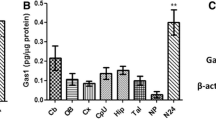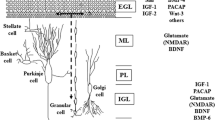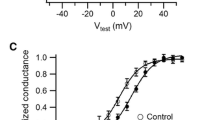Abstract
Ascorbic acid (AA) is a known antioxidant that participates in a wide range of processes, including stem cell differentiation. It enters the cell through the sodium-ascorbate co-transporter SVCT2, which is mainly expressed by neurons in the adult brain. Here, we have characterized SVCT2 expression in the postnatal cerebellum in situ, a model used for studying neurogenesis, and have identified its expression in granular precursor cells and mature neurons. We have also detected SVCT2 expression in the cerebellar cell line C17.2 and in postnatal cerebellum-derived neurospheres in vitro and have identified a tight relationship between SVCT2 expression and that of the stem cell-like marker nestin. AA supplementation potentiates the neuronal phenotype in cerebellar neural stem cells by increasing the expression of the neuronal marker β III tubulin. Stable over-expression of SVCT2 in C17.2 cells enhances β III tubulin expression, but it also increases cell death, suggesting that AA transporter levels must be finely tuned during neural stem cell differentiation.








Similar content being viewed by others
References
Harrison FE, May JM (2009) Vitamin C function in the brain: vital role of the ascorbate transporter SVCT2. Free Radic Biol Med 46(6):719–730
Nualart F, Salazar K, Oyarce K, Cisternas P, Jara N, Silva-Alvarez C, Pastor P, Martinez F et al (2012) Typical and atypical stem cells in the brain, vitamin C effect and neuropathology. Biol Res 45(3):243–256
Oyarce K, Bongarzone ER, Nualart F (2014) Unconventional neurogenic niches and neurogenesis modulation by vitamins. Journal of Stem Cell Research & Therapy 4:184
Rice ME (2000) Ascorbate regulation and its neuroprotective role in the brain. Trends Neurosci 23(5):209–216
Kratzing CC, Kelly JD, Oelrichs BA (1982) Ascorbic acid in neural tissues. J Neurochem 39(3):625–627
Schaus R (1957) The ascorbic acid content of human pituitary, cerebral cortex, heart, and skeletal muscle and its relation to age. Am J Clin Nutr 5(1):39–41
Lee JY, Chang MY, Park CH, Kim HY, Kim JH, Son H, Lee YS, Lee SH (2003) Ascorbate-induced differentiation of embryonic cortical precursors into neurons and astrocytes. J Neurosci Res 73(2):156–165
Yan J, Studer L, McKay RD (2001) Ascorbic acid increases the yield of dopaminergic neurons derived from basic fibroblast growth factor expanded mesencephalic precursors. J Neurochem 76(1):307–311
He XB, Kim M, Kim SY, Yi SH, Rhee YH, Kim T, Lee EH, Park CH et al (2015) Vitamin C facilitates dopamine neuron differentiation in fetal midbrain through TET1- and JMJD3-dependent epigenetic control manner. Stem Cells 33(4):1320–1332
Tsukaguchi H, Tokui T, Mackenzie B, Berger UV, Chen XZ, Wang Y, Brubaker RF, Hediger MA (1999) A family of mammalian Na+-dependent L-ascorbic acid transporters. Nature 399(6731):70–75
Ulloa V, Garcia-Robles M, Martinez F, Salazar K, Reinicke K, Perez F, Godoy DF, Godoy AS et al (2013) Human choroid plexus papilloma cells efficiently transport glucose and vitamin C. J Neurochem 127(3):403–414
Caprile T, Salazar K, Astuya A, Cisternas P, Silva-Alvarez C, Montecinos H, Millan C, de Los Angeles Garcia M et al (2009) The Na+-dependent L-ascorbic acid transporter SVCT2 expressed in brainstem cells, neurons, and neuroblastoma cells is inhibited by flavonoids. J Neurochem 108(3):563–577
Castro M, Caprile T, Astuya A, Millan C, Reinicke K, Vera JC, Vasquez O, Aguayo LG et al (2001) High-affinity sodium-vitamin C co-transporters (SVCT) expression in embryonic mouse neurons. J Neurochem 78(4):815–823
Qiu S, Li L, Weeber EJ, May JM (2007) Ascorbate transport by primary cultured neurons and its role in neuronal function and protection against excitotoxicity. J Neurosci Res 85(5):1046–1056
Gess B, Lohmann C, Halfter H, Young P (2010) Sodium-dependent vitamin C transporter 2 (SVCT2) is necessary for the uptake of L-ascorbic acid into Schwann cells. Glia 58(3):287–299
Garcia M, Salazar K, Millan C, Rodriguez F, Montecinos H, Caprile T, Silva C, Cortes C et al (2005) Sodium vitamin C cotransporter SVCT2 is expressed in hypothalamic glial cells. Glia 50(1):32–47
Pastor P, Cisternas P, Salazar K, Silva-Alvarez C, Oyarce K, Jara N, Espinoza F, Martinez AD et al (2013) SVCT2 vitamin C transporter expression in progenitor cells of the postnatal neurogenic niche. Front Cell Neurosci 7:119
Silva-Alvarez C, Salazar K, Cisternas P, Martinez F, Liour S, Jara N, Bertinat R, Nualart F (2016) Apical polarization of SVCT2 in apical radial glial cells and progenitors during brain development. Mol Neurobiol. (in press)
Meredith ME, Harrison FE, May JM (2011) Differential regulation of the ascorbic acid transporter SVCT2 during development and in response to ascorbic acid depletion. Biochem Biophys Res Commun 414(4):737–742
Salazar K, Martinez M, Ulloa V, Bertinat R, Martinez F, Jara N, Espinoza F, Bongarzone ER, Nualart F (2016) SVCT2 overexpression in neuroblastoma cells induces cellular branching that is associated with ERK signaling. Mol Neurobiol 53(10):6668–6679
Snyder EY, Deitcher DL, Walsh C, Arnold-Aldea S, Hartwieg EA, Cepko CL (1992) Multipotent neural cell lines can engraft and participate in development of mouse cerebellum. Cell 68(1):33–51
Manjunath N, Shankar P, Stockton B, Dubey PD, Lieberman J, von Andrian UH (1999) A transgenic mouse model to analyze CD8(+) effector T cell differentiation in vivo. Proc Natl Acad Sci U S A 96(24):13932–13937
Strebel A, Harr T, Bachmann F, Wernli M, Erb P (2001) Green fluorescent protein as a novel tool to measure apoptosis and necrosis. Cytometry 43(2):126–133
Shin DM, Ahn JI, Lee KH, Lee YS, Lee YS (2004) Ascorbic acid responsive genes during neuronal differentiation of embryonic stem cells. Neuroreport 15(12):1959–1963
Klein C, Butt SJ, Machold RP, Johnson JE, Fishell G (2005) Cerebellum- and forebrain-derived stem cells possess intrinsic regional character. Development 132(20):4497–4508
Lee A, Kessler JD, Read TA, Kaiser C, Corbeil D, Huttner WB, Johnson JE, Wechsler-Reya RJ (2005) Isolation of neural stem cells from the postnatal cerebellum. Nat Neurosci 8(6):723–729
Acuna AI, Esparza M, Kramm C, Beltran FA, Parra AV, Cepeda C, Toro CA, Vidal RL et al (2013) A failure in energy metabolism and antioxidant uptake precede symptoms of Huntington’s disease in mice. Nat Commun 4:2917
Cao N, Liu Z, Chen Z, Wang J, Chen T, Zhao X, Ma Y, Qin L et al (2012) Ascorbic acid enhances the cardiac differentiation of induced pluripotent stem cells through promoting the proliferation of cardiac progenitor cells. Cell Res 22(1):219–236
Pasonen-Seppanen S, Suhonen TM, Kirjavainen M, Suihko E, Urtti A, Miettinen M, Hyttinen M, Tammi M et al (2001) Vitamin C enhances differentiation of a continuous keratinocyte cell line (REK) into epidermis with normal stratum corneum ultrastructure and functional permeability barrier. Histochem Cell Biol 116(4):287–297
Qiao H, May JM (2009) Macrophage differentiation increases expression of the ascorbate transporter (SVCT2). Free Radic Biol Med 46(8):1221–1232
Savini I, Catani MV, Rossi A, Duranti G, Melino G, Avigliano L (2002) Characterization of keratinocyte differentiation induced by ascorbic acid: protein kinase C involvement and vitamin C homeostasis. The Journal of investigative dermatology 118(2):372–379
Takahashi T, Lord B, Schulze PC, Fryer RM, Sarang SS, Gullans SR, Lee RT (2003) Ascorbic acid enhances differentiation of embryonic stem cells into cardiac myocytes. Circulation 107(14):1912–1916
Takamizawa S, Maehata Y, Imai K, Senoo H, Sato S, Hata R (2004) Effects of ascorbic acid and ascorbic acid 2-phosphate, a long-acting vitamin C derivative, on the proliferation and differentiation of human osteoblast-like cells. Cell Biol Int 28(4):255–265
Wu X, Zeng LH, Taniguchi T, Xie QM (2007) Activation of PKA and phosphorylation of sodium-dependent vitamin C transporter 2 by prostaglandin E2 promote osteoblast-like differentiation in MC3T3-E1 cells. Cell Death Differ 14(10):1792–1801
Haramoto M, Tatemoto H, Muto N (2008) Essential role of ascorbic acid in neural differentiation and development: high levels of ascorbic acid 2-glucoside effectively enhance nerve growth factor-induced neurite formation and elongation in PC12 cells. J Health Sci 54(1):43–49
Lau T, Adam S, Schloss P (2006) Rapid and efficient differentiation of dopaminergic neurons from mouse embryonic stem cells. Neuroreport 17(10):975–979
Yu DH, Lee KH, Lee JY, Kim S, Shin DM, Kim JH, Lee YS, Lee YS et al (2004) Changes of gene expression profiles during neuronal differentiation of central nervous system precursors treated with ascorbic acid. J Neurosci Res 78(1):29–37
Bowie AG, O’Neill LA (2000) Vitamin C inhibits NF-kappa B activation by TNF via the activation of p38 mitogen-activated protein kinase. J Immunol 165(12):7180–7188
Lee SA, Son YO, Kook SH, Choi KC, Lee JC (2011) Ascorbic acid increases the activity and synthesis of tyrosinase in B16F10 cells through activation of p38 mitogen-activated protein kinase. Arch Dermatol Res 303(9):669–678
Wang T, Chen K, Zeng X, Yang J, Wu Y, Shi X, Qin B, Zeng L et al (2011) The histone demethylases Jhdm1a/1b enhance somatic cell reprogramming in a vitamin-C-dependent manner. Cell Stem Cell 9(6):575–587
Young JI, Zuchner S, Wang G (2015) Regulation of the epigenome by vitamin C. Annu Rev Nutr 35:545–564
Prosch S, Stein J, Staak K, Liebenthal C, Volk HD, Kruger DH (1996) Inactivation of the very strong HCMV immediate early promoter by DNA CpG methylation in vitro. Biol Chem Hoppe Seyler 377(3):195–201
Kong Q, Wu M, Huan Y, Zhang L, Liu H, Bou G, Luo Y, Mu Y et al (2009) Transgene expression is associated with copy number and cytomegalovirus promoter methylation in transgenic pigs. PLoS One 4(8):e6679
Mehta AK, Majumdar SS, Alam P, Gulati N, Brahmachari V (2009) Epigenetic regulation of cytomegalovirus major immediate-early promoter activity in transgenic mice. Gene 428(1–2):20–24
Leung PY, Miyashita K, Young M, Tsao CS (1993) Cytotoxic effect of ascorbate and its derivatives on cultured malignant and nonmalignant cell lines. Anticancer Res 13(2):475–480
Paolini M, Pozzetti L, Pedulli GF, Marchesi E, Cantelli-Forti G (1999) The nature of prooxidant activity of vitamin C. Life Sci 64(23):PL 273–PL 278
Acknowledgements
This work was funded by FONDECYT 1140477 (to FN) and ECM-12 CMA BIO PIA-CONICYT (to FN) grants.
Conflict of interest
The authors declare that they have no conflict of interest.
Author information
Authors and Affiliations
Corresponding author
Rights and permissions
About this article
Cite this article
Oyarce, K., Silva-Alvarez, C., Ferrada, L. et al. SVCT2 Is Expressed by Cerebellar Precursor Cells, Which Differentiate into Neurons in Response to Ascorbic Acid. Mol Neurobiol 55, 1136–1149 (2018). https://doi.org/10.1007/s12035-016-0366-5
Received:
Accepted:
Published:
Issue Date:
DOI: https://doi.org/10.1007/s12035-016-0366-5




